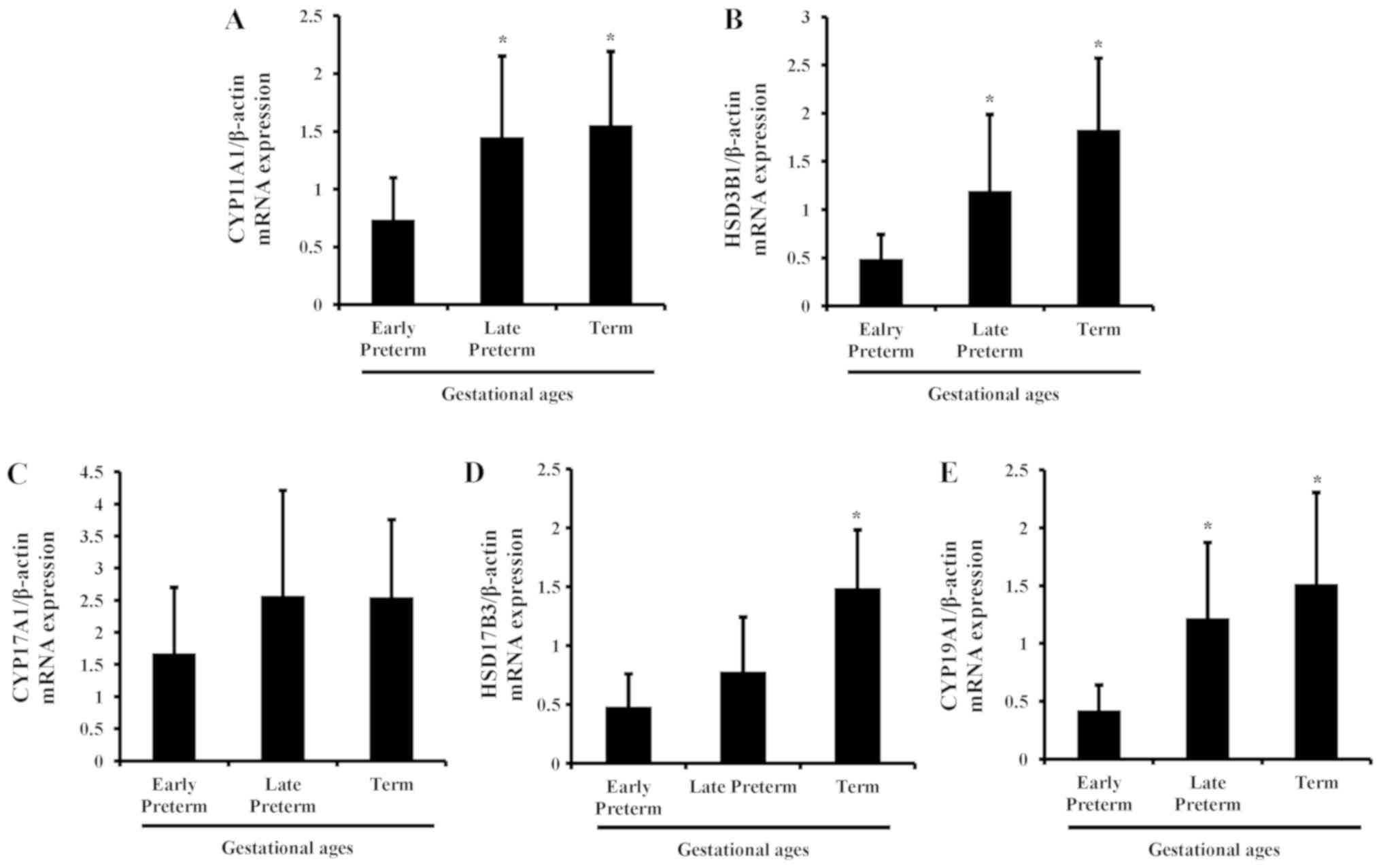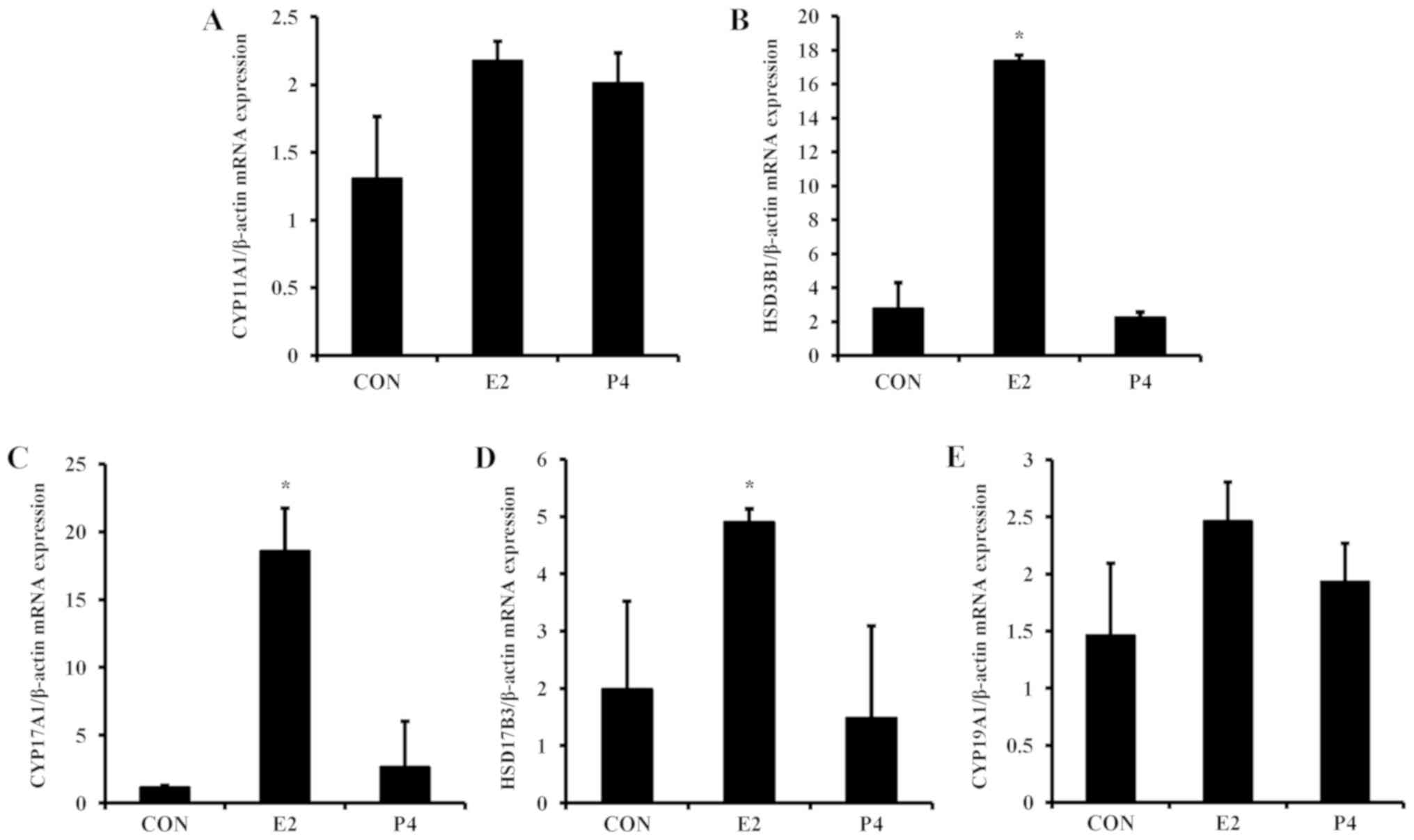Expression of steroidogenic enzymes in human placenta according to the gestational age
- Authors:
- So‑Hye Hong
- Seung Chul Kim
- Mee‑Na Park
- Jea Sic Jeong
- Seung Yun Yang
- Young Joo Lee
- Ok‑Nam Bae
- Hoe‑Saeng Yang
- Sungbaek Seo
- Kyu‑Sup Lee
- Beum‑Soo An
View Affiliations
Affiliations: Department of Biomaterials Science, College of Natural Resources and Life Science/Life and Industry Convergence Research Institute, Pusan National University, Busan, Gyeongsangnam 50463, Republic of Korea, Department of Obstetrics and Gynecology, Biomedical Research Institute, School of Medicine, Pusan National University, Busan, Gyeongsangnam 49241, Republic of Korea, College of Pharmacy, Hanyang University, Ansan, Gyeonggi 15588, Republic of Korea, Department of Obstetrics and Gynecology, Medical College, Dongguk University, Seoul 04620, Republic of Korea
- Published online on: March 15, 2019 https://doi.org/10.3892/mmr.2019.10048
-
Pages:
3903-3911
Metrics: Total
Views: 0 (Spandidos Publications: | PMC Statistics: )
Metrics: Total PDF Downloads: 0 (Spandidos Publications: | PMC Statistics: )
This article is mentioned in:
Abstract
Female sex steroid hormones, including estradiol (E2) and progesterone (P4), serve significant physiological roles in pregnancy. In particular, E2 and P4 influence placenta formation, maintain pregnancy and stimulate milk production. These hormones are produced by ovaries, adrenal glands and the placenta, of which the latter is a major endocrine organ during pregnancy. However, the mechanism of hormone production during pregnancy remains unclear. In the present study, the regulation of steroid hormones and steroidogenic enzymes was examined in human placenta according to gestational age. In human placental tissues, expression levels of steroidogenic enzymes were determined with reverse transcription‑quantitative polymerase chain reaction and western blotting. The mRNA and protein expression of CYP17A1, HSD17B3 and CYP19A1, which are associated with the synthesis of dehydroepiandrosterone (DHEA) and E2, was elevated at different gestational ages in human placenta. In addition, to evaluate the correlation between serum and placental‑produced hormones, steroid hormone levels, including pregnenolone (PG), DHEA, P4, testosterone (T) and E2, were examined in serum and placenta. Serum and placenta expression of DHEA and E2 increased with gestational age, whereas T and P4 were differently regulated in placenta and serum. To confirm the mechanism of steroidogenesis in vitro, placental BeWo cells were treated with E2 and P4, which are the most important hormones during pregnancy. The mRNA and protein expression of steroidogenic enzymes was significantly altered by E2 in vitro. These results demonstrated that concentration of steroid hormones was differently regulated by steroidogenic enzymes in the placenta depending on the type of the hormones, which may be critical to maintain pregnancy.
View References
|
1
|
Pijnenborg R, Bland JM, Robertson WB,
Dixon G and Brosens I: The pattern of interstitial trophoblastic
invasion of the myometrium in early human pregnancy. Placenta.
2:303–316. 1981. View Article : Google Scholar : PubMed/NCBI
|
|
2
|
Gude NM, Roberts CY, Kalionis B and King
RG: Growth and function of the normal human placenta. Thromb Res.
114:397–407. 2004. View Article : Google Scholar : PubMed/NCBI
|
|
3
|
Gailly-Fabre E, Kerlan V and
Chirstin-Maitre S: Pregnancy-associated hormones and fetal-maternal
relations. Ann Endocrinol (Paris). 76:S39–S50. 2015. View Article : Google Scholar : PubMed/NCBI
|
|
4
|
Albrecht ED and Pepe GJ: Estrogen
regulation of placental angiogenesis and fetal ovarian development
during primate pregnancy. Int J Dev Biol. 54:397–408. 2010.
View Article : Google Scholar : PubMed/NCBI
|
|
5
|
Gruber CJ, Tschugguel W, Schneeberger C
and Huber JC: Production and actions of estrogens. N Engl J Med.
346:340–352. 2002. View Article : Google Scholar : PubMed/NCBI
|
|
6
|
Zhu BT and Conney AH: Functional role of
estrogen metabolism in target cells: Review and perspectives.
Carcinogenesis. 19:1–27. 1998. View Article : Google Scholar : PubMed/NCBI
|
|
7
|
Murphy VE, Smith R, Giles WB and Clifton
VL: Endocrine regulation of human fetal growth: The role of the
mother, placenta, and fetus. Endocr Rev. 27:141–169. 2006.
View Article : Google Scholar : PubMed/NCBI
|
|
8
|
Pepe GJ and Albrecht ED: Actions of
placental and fetal adrenal steroid hormones in primate pregnancy.
Endocr Rev. 16:608–648. 1995. View Article : Google Scholar : PubMed/NCBI
|
|
9
|
Payen AH and Hales DB: Overview of
steroidogenic enzymes in the pathyway from cholesterol to active
steroid hormones. Endocr Rev. 25:947–970. 2004. View Article : Google Scholar : PubMed/NCBI
|
|
10
|
Miller WL and Auchus RJ: The molecular
biology, biochemistry, and physiology of human steroidogenesis and
its disorders. Endocr Rev. 32:81–151. 2011. View Article : Google Scholar : PubMed/NCBI
|
|
11
|
Siemieniuch MJ, Jursza E, Szostek AZ,
Skarzynski DJ, Boos A and Kowalewski MP: Steroidogenic capacity of
the placenta as a supplemental source of progesterone during
pregnancy in domestic cats. Reprod Biol Endocrinol. 10:892012.
View Article : Google Scholar : PubMed/NCBI
|
|
12
|
Verduzco A, Fecteau G, Lefebvre R, Smith
LC and Murphy BD: Expression of steroidogenic proteins in bovine
placenta during the first half of gestation. Reprod Fertil Dev.
24:392–404. 2012. View
Article : Google Scholar : PubMed/NCBI
|
|
13
|
Furukawa S, Kuroda Y and Sugiyama A: A
comparison of the histological structure of the placenta in
experimental animals. J Toxicol Pathol. 27:11–18. 2014. View Article : Google Scholar : PubMed/NCBI
|
|
14
|
Kim SC, Park MN, Lee YJ, Joo JK and An BS:
Interaction of steroid receptor coactivators and estrogen receptors
in the human placenta. J Mol Endocrinol. 56:239–247. 2016.
View Article : Google Scholar : PubMed/NCBI
|
|
15
|
Gambino YP, Perez Perez A, Duenas JL,
Calvo JC, Sanchez-Margalet V and Varone CL: Regulation of leptin
expression by 17beta-estradiol in human placental cells involves
membrane associated estrogen receptor alpha. Biochim Biophys Acta.
1823:900–910. 2012. View Article : Google Scholar : PubMed/NCBI
|
|
16
|
Frazier K, Wallace K and LaMarca B:
Progesterone inhibits trophoblast TNF alpha production. The FASEB
J. 24:2010.
|
|
17
|
Livak KJ and Schmittgen TD: Analysis of
relative gene expression data using real-time quantitative PCR and
the 2−ΔΔCT method. Methods. 25:402–408. 2001. View Article : Google Scholar : PubMed/NCBI
|
|
18
|
Costantine MM: Physiologic and
pharmacokinetic changes in pregnancy. Front Pharmacol. 5:652014.
View Article : Google Scholar : PubMed/NCBI
|
|
19
|
Kurnar P and Magon N: Hormones in
pregnancy. Niger Med J. 53:179–183. 2012. View Article : Google Scholar : PubMed/NCBI
|
|
20
|
Robboy SJ and Hoda RS: Pathology of the
human placenta. Int J Gynecol Pathol. 19:4012000. View Article : Google Scholar
|
|
21
|
Rodeck CH, Gill D, Rosenberg DA and
Collins WP: Testosterone levels in midtrimester maternal and fetal
plasma and amniotic fluid. Prenat Diagn. 5:175–181. 1985.
View Article : Google Scholar : PubMed/NCBI
|














